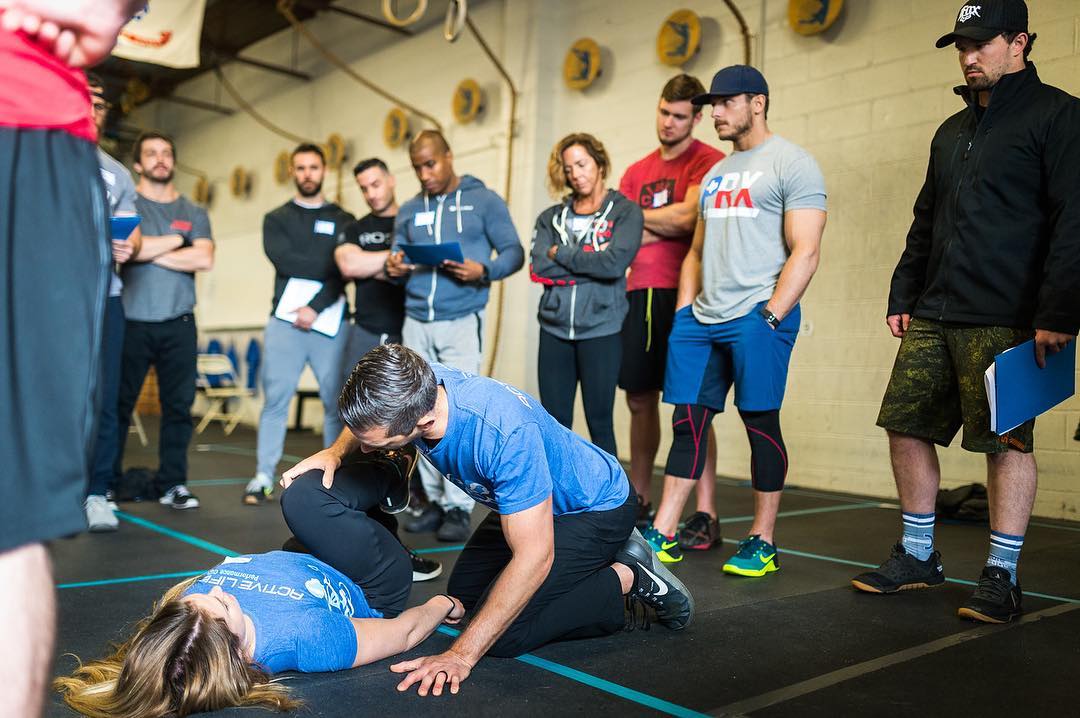How to Fix Anything, Part 3: “I Know This”
This is part three in a three-part series by Dr. Sean Pastuch, founder and owner of Active Life Rx. Dr. Sean examines his own nagging injury incurred while training with Rich Froning in Cookeville six months earlier. Still in pain and making no improvement despite trying everything he could, Dr. Sean begins to take a different approach to healing his injury. You can read part one here and part two here.
I was sitting back, enjoying Dr. Ray’s lecture titled “How Injuries Occur” when I realized I was missing the simplest thing. My solution was right in front of my face and I had been prescribing it to dozens of my clients every day. About halfway through his lecture, Ray nonchalantly made the statement that turned this entire thing around for me.
“Pain is an emotion. We can’t depend on the pain experience of our clients as a reliable piece of data to determine what exercises they need to do and what exercises they need to avoid.” I’m paraphrasing Dr. Ray. “Soft tissues need load if they are going to change. The amount of load, the vector of load, and the duration for which load is experienced will all depend on the type of injury and the reaction to the load. The only way we are going to know what we need to do is to assess, act, and pivot based on the body’s response.”
Holy shit. How could I have forgotten the simplest principle we teach?
I was missing the simplest thing. My solution was right in front of my face and I had been prescribing it to dozens of my clients every day…How could I have forgotten the simplest principle we teach?
I was in it. I was too deep. I couldn’t see the forest because I was just staring at trees. I forgot my basics. And that’s where I found myself very much in your shoes.

When I say “your shoes,” I mean that you’re not a doctor and you shouldn’t know this. But I was in a place where I literally could not apply any of my clinical knowledge to myself. I was acting emotionally and reactively. I imagine that when you get hurt, this is how you act. It’s how your friends act. I know it’s how my clients act before we start working with them at Active Life. Our entire initial conversation covers the concept of emotion.
And this realization reminded me that assessment is the key to fixing anything. If you want to be a faster runner the most important thing for us to know is how fast you can run currently. If you want to be a stronger squatter we need to know how much you currently squat. If you want to improve your Fran time we need to know your current Fran time. And if we want to get rid of your pain-causing condition, we need to know what your condition is. We need to know how your body responds to load. And we need to be prepared to pivot and progress the stimulus we apply.
Proper assessment is the key to fixing anything. Of course, proper implementation of intervention is the next necessary step, but how can we know what to do if we don’t know the current capacity?
We cannot.
For me, the necessary steps were to implement various exercises with the following parameters:
- Pain was a 4/10 or less and did not get worse as the work went on.
- Pain was gone within moments of putting the weight down.
- The pain was not worse upon waking up the following day.
- That’s it. Provided that those factors remained, the exercise selection was appropriate.
My “rehab” consisted of farmer’s carries, bicep curls, inverted rows, and bent-over barbell rows to directly impact the brachialis muscle. I also included plank holds on my hands, bar hangs, and tricep extensions to stabilize the elbow.
Within three weeks I was able to clean a 75-pound barbell without pain. Ninety-five pounds came shortly thereafter and only ten weeks after that, I was back to cleaning PR weights without pain.
Quick fixes don’t work and they’re dangerous. It is easy to see why someone would quit and think they need to live with their aches and pains. It’s easy to see why someone would think they’ve tried everything…When it doesn’t work for you, it’s easy to believe that something is wrong with you or that your condition will be permanent.
Here is the take-home message for you: quick fixes don’t work and they’re dangerous. It is easy to see why someone would quit and think they need to live with their aches and pains. It’s easy to see why someone would think they’ve tried everything. The problem with quick fixes is that 10% of the time, they work for 10% of the people who do them. I made those numbers up, but the point is that they worked for someone, once, so that someone becomes the shining example. When it doesn’t work for you, it’s easy to believe that something is wrong with you or that your condition will be permanent. After all, if a YouTube video has 100,000 views and 20 comments about how great it is, it should work for you, right?
Wrong! 20 comments out of 100,000 views is a small number. And the fix will work for some people; it will work for the people who, if assessed, would have been prescribed the fix. The square peg works great if you’re a square hole.
When the intervention fits the need, results occur.
Please let my story be a lesson to you. Quick fixes work sometimes, but that’s not where you should put all of your hopes. Quality assessment and carefully planned correction based on your assessment result is the way to fix anything. And now you know.